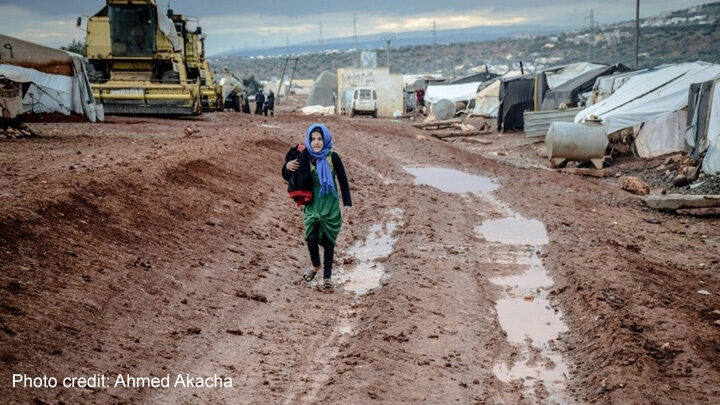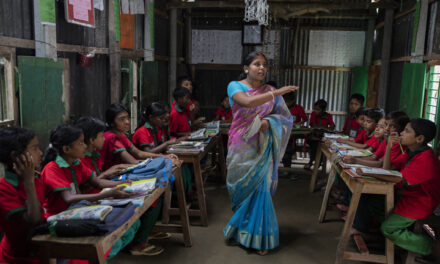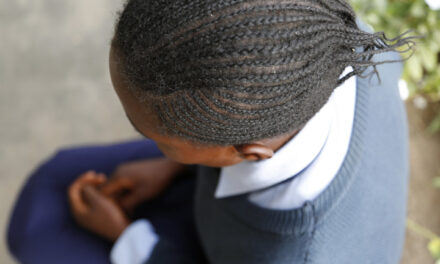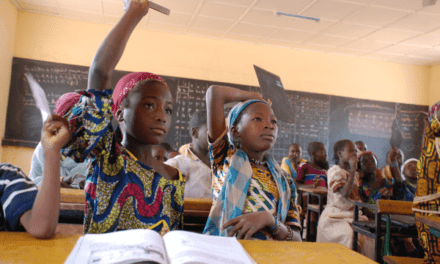This post was written by Sharon Tao, Director of Level The Field. This is an abridged version of the first of four blogs in a new series, published on Level the Field on 3 July 2025.
In 2021, the G7 endorsed two Global Objectives to be achieved by 2026 in low- and lower-middle-income countries: 1) 40 million more girls in school; and 2) 20 million more girls reading by the end of primary. These objectives recognise that marginalised girls are often left furthest behind as a result of the ‘double disadvantage’ that harmful gender norms impose.
The recently launched Third Annual Global Objectives Report has a focus on Education in Emergencies and Protracted Crises (EiEPC) because the ability to get marginalised girls into school and learning is significantly affected by conflict, climate crisis, political insecurity, and in many cases, a combination of these.
Crises do not discriminate and disadvantage everyone caught within them. However, those who were most marginalised prior to a crisis will also likely suffer the greatest disadvantage during and after the crisis. Within these marginalised groups, harmful gender norms are exacerbated and put girls at an even greater disadvantage than boys. Examples of this include conflict-related sexual violence (CRSV) such as rape, sexual slavery and forced marriage, amongst others. Boys may experience CRSV, but it is more likely that they will be recruited by armed groups, which puts them at an increased risk of death or disability from conflict, and can also increase their likelihood of perpetrating CRSV.
There is wide recognition that education offers protection and skills during crises, particularly for girls. Thus, this year’s Global Objectives report examines progress on girls’ access and learning through the lens of EiEPC. The following are key findings from the report and accompanying recommendations:
Finding: Both Global Objectives are significantly off-track, and strategic action is required for substantive progress to be made by 2026. Although this finding is for the reporting period of 2023, it is set against a backdrop of ever-changing politics, priorities and aid budgets. This instability presents a significant challenge for the achievement of the Global Objectives, but investment in the stability and security effects of girls’ education are even more imperative in a global context that has become increasingly volatile.
Recommendation 1: Continue strategic engagement with and investment in the Global Objectives where possible, particularly in conflict- and crisis-affected contexts. G7 partners should also aim to influence ministries, donors and other actors to align with the achievement of the Global Objectives so that ownership reaches beyond the G7.
Finding: Harmful gender norms seriously undermine achievement of the Global Objectives, most notably in crisis contexts. Nine of the 12 countries with between 40-75% of school-aged girls out of school were experiencing severe crisis. These countries also had the largest gender gaps in relation to boys, which illustrates how crisis exacerbates harmful gender norms. Moreover, these norms also result in boys dropping out, as mothers and women are excluded from labour markets, thereby putting pressure on boys to supplement family incomes.
Recommendation 2: Support EiEPC programming that aims to advance gender equality and targets gender norms: 1) in education (i.e. amongst teachers, pedagogy, materials); 2) around education (i.e. amongst parents, communities); and 3) through education (i.e. as a result of all parts of the education system actively challenging unequal norms).
Finding: The data used for Global Objectives reporting significantly limit the ability to monitor progress and target support, particularly in crisis contexts. Although the Global Objectives were designed to provide stepping stones to achieve key SDG indicators, the additional aim of helping G7 partners better target their education support requires a broader set of data than what is currently being used.
Recommendation 3: The data used to report on out-of-school (OOS) girls do not include all girls who are OOS in crisis-affected contexts, and they should. There is work in train by the Education Data and Statistics Commission (EDSC) Task Force to adjust global-level data to include OOS children in crisis contexts. Encouragingly, since the compilation of this report, UIS have updated their data for 2023, which now incorporate data from ten conflict zones. Whilst this is a positive step, EDSC work should be prioritised so that all crisis-affected children are included in global OOS data.
Recommendation 4: The data used for girls’ reading should include additional data sources in order to provide a clearer picture of which girls aren’t reading. There are several data sources that glean reading data at the household level; thereby including OOS children, reaching more crisis-affected areas and assessing in more languages. These data sources should supplement current reading data in future Global Objectives reports in order to help G7 partners and the global community better target education support.
Finding: Education in crisis contexts offers stability, protection and a second chance to the most disadvantaged – but there is no global system for measuring the impact of this provision. As a result, education in emergencies is overlooked and not included in the Global Objectives or SDG data. The Global Education Cluster reports on the ‘reach’ of humanitarian funding for education in emergencies, but it only captures some of what is being achieved.
Recommendation 5: The global community should invest in better monitoring of the impact of education in emergencies investments across humanitarian and development programming and improve the definition of the term ‘reach’. Although this would take significant political, technical and structural effort, it is something to consider if education in emergencies is to be taken seriously and incorporated in Global Objectives or SDG reporting.
Finding: Non-formal education (NFE) in crisis and non-crisis contexts offers stability, protection and a second chance to disadvantaged girls – but definitions and data do not include NFE because it is not considered ‘school’. NFE, and the most marginalised children to whom it caters, should be captured in definitions of ‘education’ so that they are accounted for in MoE planning, budgeting, certification and monitoring. Such a shift is something to consider if the Leave No One Behind agenda is to be taken seriously.
Recommendation 6: Advocate for the need to include children served by quality NFE within definitions of and data used for ‘education’, particularly as we approach 2030 and discussions of a successor system to the SDGs.
A detailed discussion of these findings and recommendations can be found in the G7 Global Objectives Report on Education in Emergencies and Protracted Crises. In addition, a series of blogs will be launched over the coming months to provide synopses of the key themes contained in the report; and this will culminate in a presentation at the UKFIET Conference in September 2025.
Overall, in a global context of increasing crises, budget cuts and political volatility, it is hoped that this report demonstrates that although marginalised girls continue to be left behind, there is still an opportunity to support the Global Objectives to get more of these girls back into school and learning. Given the stability and security effects of girls’ education, this support makes sense now, more than ever.





